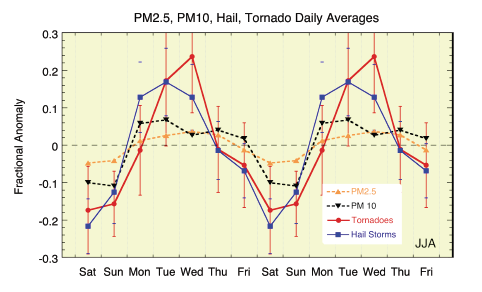

I’ve written previously about research conducted by Thomas Bell, a scientist based at NASA’s Goddard Space Flight Center, that shows lightning storms tend to occur during the middle of the week when air pollution levels are the highest. An update: Bell has recently published more research showing the effect extends to hail storms and tornadoes as well. Here’s how Bell summarizes his latest work in a short write-up posted on a page from Goddard’s atmospheric science branch. For a more detailed explanation of how air pollution can fuel hail and tornadoes, you can read the full scientific paper (pdf) published by the Journal of Geophysical Research.
Hailstorm and tornado activity increases in the middle of the work week (Tuesday-Thursday) compared to weekends. Weekly cycles in weather behavior are a clear sign of human influence on our climate. The weekly cycle is believed to be caused by the well-known weekly changes in pollution levels with the day of the week. Aerosol pollution decreases the size of water droplets coalescing in clouds. They are lighter and don’t fall out as rain, but instead rise to much higher altitudes where they freeze and release additional heat. This invigorates the storm and produces more ice aloft. This might explain the increase in hailstorms as well as the increase in lightning that has also been observed. It is conjectured by Rosenfeld and Bell, based on numerical model simulations, that storms, amped up by pollution, nevertheless produce weaker cold pools at their base. Tornadoes develop less easily when a cold, rapidly moving pool forms beneath the storm. By weakening cold pool formation, pollution may lead to storms with better chances of forming a tornado than is the case for storms formed in clean air.

Text by Adam Voiland. Video showing lightning storms from the perspective of the International Space Station was posted originally on Johnson Space Center’s Crew Earth Observations Office website. Graphic comparing pollution levels, hail, and tornadoes from Bell’s 2011 JGR paper.